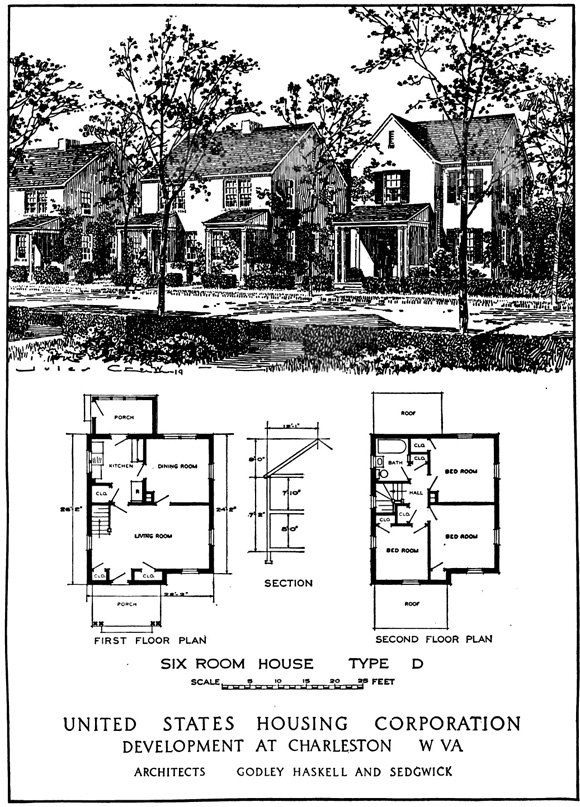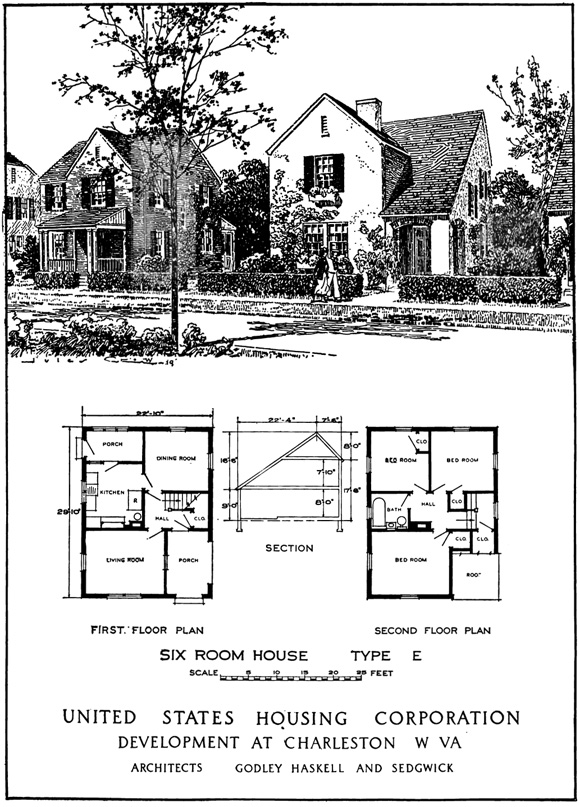Charleston, WV
General Description (1919 report):
"The city of Charleston, W. Va., on the north bank of the Kanawha River, had grown from a population of about 11,000 in 1900 to about 40,000 people in 1918. This industrial growth, due to natural resources of coal, oil, gas, and clay and excellent transportation facilities, while much stimulated by war conditions, seemed likely to be for the most part permanent. The town had spread along the river, the manufacturing plants on the lower river bank land, the dwellings for the most part on the broken higher land back from the stream..."
"The Naval Ordnance Works, consisting of a naval projectile plant, a naval gun-forging plant, and a Government armor plant, being under erection early in 1918, and it being evident that there would not be by any means sufficient housing for its prospective employees, the Navy Department called upon the Housing Corporation to investigate and to expend such sums as might properly be allotted for housing in connection with this plant. The Navy Department offered without cost a perpetual lease of a tract of land of 16.3 acres adjacent to the ordnance plan on the river bank."

1919 excerpt describing the design of the Charleston, WV site:
Area planned: 16.28 acres. Housing planned: Detached houses, 47 families; semidetached houses, 40 families; total, 87 families. Housing constructed: Detached houses, 45 families; semidetached houses, 40 families. Total, 85 families.
"In addition to the housing site, about 17 acres of land across Eighth Avenue was chosen as a park playground. Near Eighth Avenue there is a level area and then a wooded valley, the trees on the farther slope of which serve to screen the armor plate plant on the hill beyond from the park and from the houses on the river bank. The housing site is open and fairly level, lying about 45 feet above the river at ordinary stages of the water. "
"The street and block system of the development was arranged with the fact in mind that no through traffic need be provided for within the development, that the streets should lead easily to a stop on the car line in Eighth Avenue, and that the view over the Kanawha River was worth preserving and enhancing."
"Since the land was free the lots were made a little larger than common. The houses were carefully arranged so that as far as possible the service sices of two adjacent houses should face each other, and, therefore, the living sides should enjoy the best available outlook. The use of certain house plans 'reversed' facilitates this as well as giving general variety."
"The houses are of terra cotta, stuccoed. The first impression which the houses give is that of too great similarity and a certain barrenness. Had there been a greater variety of types and color the appearance would have been improved. Much of the difficulty arises, however, from the fact that the house designs were among the first that were submitted to the corporation, and that before being constructed several minor details, such as blinds, very important in the appearance of the houses, were omitted for economy. Some of these may later be replaced. The houses are, however, very well designed and the plans carefully worked out."
The Charleston Site Today
Renderings, 1919



